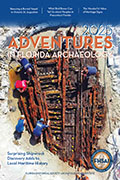
Anyone who knows and/or loves newspapers knows the sayings:
“Your mother says she loves you, check it out.”
The mast head slogans:
“Democracy Dies in Darkness.”
And of course, the famous summary:
“News is the first rough draft of history.” (Popularized by the Washington Post’s Philip Graham ((1915-1963)) the phrase is actually attributed to WaPo’s long time editorial writer Alan Barth who used it several times in the 1940s. But, that is another story.)
Newspapers figure in a saying bandied about in fast growing post-Civil War Florida, too: “All you need for a town is a church, a jail and a newspaper.” (https://myfloridahistory.org/ webextras/webextras/87)
That was an expression rooted in Florida history from the 18th century and the short-lived East Florida Gazette, 1783-4, covering St. Augustine, a weekly bringing the world to that little corner of the empire (https://chroniclingamerica.loc.gov/lccn/sn82016471/) It was followed by 41 local papers published around Florida under American control between 1821 and 1845. You can locate most Florida papers in digital archives: https://dos.myflorida.com-/library-archives/research/florida-information/florida-newspapers-online/ and : https://ufdc.ufl.edu /fdnl1 .
All this digital access is fabulous of course for historians, genealogists and social researchers looking for primary documents and facts.

For a taste of the real thing you have to visit an archive or research library such as the Library of Florida History in Cocoa. There, as archivist Ben DiBiase outlines in a segment of Florida Frontiers Radio (https://myfloridahistory.org /frontiers/radio/program/397) you can touch a bit of the first draft of 100 year old history just the way your ancestors would have if they lived in Jacksonville between January 1917 and the end of December, 1918.

Open to any front page of these bound editions of the Jacksonville Times-Union, donated to the Florida Historical Society a century ago to facilitate research on World War I, and you can feel the impact of the ink on broadsheet conveying the lost hopes for peace, the changes in the lives of young men called to war, even the costs to the taxpayer, as laid out by crusty editors intent on displaying the reality of their world.

Look beyond the front page and you are drawn farther into that world. An inside page story brings a bit of the war home.

A few pages later a confirmation of the ‘first draft of history’ conceit - the first reports of a loss that would devastate a city (https://www.tampabay.com/news/military/war/Sunk-by-torpedo-a-century-ago-USS-Tampa-left-a-legacy-of-protection-_171794676/) and a war-time diminished report about the epidemic then sweeping the world.
Of course, it is not just the ‘hard news’ that defines the times.

Ads offer insights at several levels. They define the emerging technology and service industry of the era as well as, if you look closely near where the pages are bound, the costs. While we might envy fillings for 50 cents, remember the average household annual income in 1918 was about $1,500.

Other ads assure us some established brands were still going strong, including a now defunct shoe polish company which lives on as a rude colloquialism (if you don’t understand, ask your grandfather).

Speaking of emerging technologies, the traditional art and drama page still had references to local performances, but already was dominated by the new fangled ‘moving pictures’. It seems the baseball term ‘fans’ was already catching on with the newspaper writers in the new context.
Then as now, Sunday was always the ‘big’ paper, with special sections, the first installments of investigative series, more ads and the special comics.

As cringe-worthy as they might appear to us, the comics actually offer some interesting insights into the attitudes of the readers as well as the newspaper (mainly older and white) men.

Apparently anything, including blackface characters and possible child abuse was funny as long as it ended with a high sounding moral lesson.
Even though the newspaper business was predominantly a male endeavor, there was a feminine side.

There were female reporters and writers, for the most part confined, at least for the early part of their careers, to the ‘Women’s Pages.’ Women in the community could contribute articles on topics ‘of interest to women.’ Fortunately that could include topics ranging worldwide. For all this, the Times Union, begun after the Civil War as a pro-Union paper, actually had a big role to play in the passage of women’s suffrage.
Looking back, one can’t help but wonder about the things not said:


Another area where not much was said was the African American community.

For all the war coverage on this particular day, you have to look carefully, alongside the casualty lists, for a two- column-inch story about African American students being allowed to serve. At that, you have to know the Florida University System to realize who they are talking about. It appears the white editors did not want to take a chance identifying the new Doughboys by ethnicity.
As far as the Times Union was concerned, when black society rubbed up against white society, the story was told from the white society point of view. The answer to that, of course, was creation of a black press.

Courtesy the Randolph Society
One influential black journalist who contributed to that effort was John Willis Menard (1838-1893) who ran a paper first called The Florida News, and later the Southern Leader, in Jacksonville between 1885 and 1888, when a yellow fever epidemic forced it to close. The paper was only one part of Menard’s fascinating life ( https://www.britannica.com /biography/John-Willis-Menard, and he is no stranger to the Florida Historical Society (https://www.jstor.org/stable/30146099).
But, as we say, that is another story.
As is The Florida Times Union (https://www.jacksonville.com/), still publishing in Jacksonville. The printing is done elsewhere, but the newsroom is still downtown. Thanks to the newspaper’s management a century ago, school kids visiting the Library of Florida History today can experience a ritual from another time. Often it is a bit of a thrill, most of them have never seen a hard copy newspaper.







